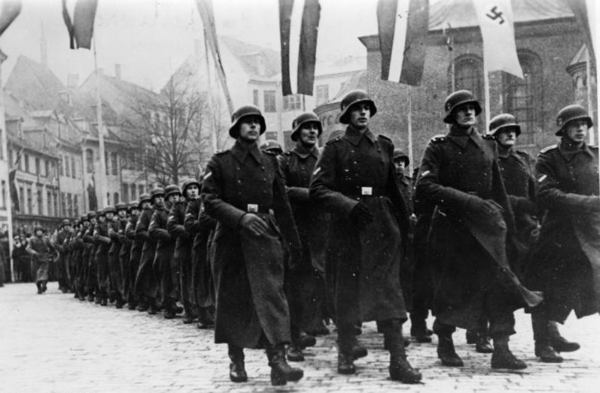Nazi Foreign Legions
Almost 350,000 men served in Hitler’s Foreign Legions during World War Two. These Legions were filled with non-German volunteers, who were normally recruited from Nazi occupied nations. Many men volunteered because they wanted to fight against the communist USSR.
The Waffen-SS was the military wing of the SS. It originally consisted of four sections of ethnic Germans, but it increased into a mass unit of 900,000 men across 41 divisions. At one point, more than a third of its force consisted of volunteers. A lot of these men fought in opposition to the Red Army. At the end of the war it is estimated that up to Waffen-SS 750,000 members had been killed or injured in combat with another 70,000 missing in action. Accurate figures are hard to calculate because much of the Waffen-SS records were destroyed.
After the Wehrmacht’s military successes of 1939-1940, a recruitment campaign began in July 1940 in Western Europe. A more sustained campaign started the following summer. In June 1941 Nazi Germany launched Operation Barbarossa, the Nazi invasion of the Soviet Union. The attack started off by being very successful. Against this backdrop, the Nazis led a sustained recruitment campaign to find volunteers willing to fight against the Bolsheviks. After the Bolshevik Revolution of 1917, many people in the West of Europe had demonised the communist USSR. Thus it was not a surprise that many men joined the Waffen-SS. Surviving lists of recruits show that 125,000 men in occupied Western Europe signed up to volunteer. The Baltic States and the Ukraine were keen to free themselves from the USSR. The Baltic States and the Ukraine had more than 200,000 of their men join up. Recruitment from Eastern Europe meant the SS needed to dilute its initial recruitment requirements to do with ‘racial purity’.

Foreign Legion recruits did not have the same training as standard German Wehrmacht recruits. Training lasted for only two or three weeks. The Nazis were keen to get the recruits to the front line as quickly as possible. In contrast to the Wehrmacht infantry, who were taught specific skills needed by an infantryman, Waffen-SS foreign members were quickly taught varied skills in order to be sent wherever they needed to be. This very basic training schedule helps make sense of the large casualty rates in the foreign Waffen-SS units.
The SS Foreign Legions men were treated in a different way to national German Waffen-SS soldiers. They wore different insignia on their uniforms: most men in the Foreign Legions did not wear the SS insignia. German Waffen-SS and Heinrich Himmler (their commanding officers) stipulated that their units should be called Divisions of the SS rather than SS Divisions. A lot of men in the SS foreign legions spoke only their own language. They were commanded by German nationals, causing significant communication problems.
The majority of the Foreign Legions fought on the Eastern Front. Hitler had found the Battle of Stalingrad to be a disaster, but he still believed that he could defeat the Red Army. Some foreign units managed to earn a good fighter reputation: for example, the Walloon Division led by Lèon Degrelles. Others did not have as much success on the front line and were used to fight partisan groups.
The German army could not defeat the Red Army. However, once defeat became inevitable, the men who survived the Eastern Front were not able to just pack their bags and go back home as many would be considered traitors in their home nation. This could be an explanation for why so many Foreign Legion Units fought to the point of being reckless. If they were captured alive by the Red Army, they were worried about being positioned back in their country of origin. The 60,000 Russian Waffen-SS recruits faced potential execution. This fate was assigned to thousands of Cossacks.
Surviving Serbian recruits, who had fought in the Serbian Volunteer Corps, were beheaded on the orders of Marshal Tito. John Amery, head of the British Freikorps, was tried for treason and hanged. Other members were sentenced to terms in prison. Lengthy prison sentences of up to 15 years were introduced in Norway and Denmark. Commander of the Walloon SS, Lèon Degrelles, fled to Spain and was sentenced to death for treason in absentia. He continued to live there until he died in 1987.
Figures for European recruits to the Waffen-SS:
- Albanian: 3,000
- Belgian: Flemish 23,000
- Belgium: Walloon 15,000
- British Commonwealth: (English) 50
- Bulgaria: 1,000
- Croatia: 30,000
- Denmark: 10,000
- Estonia: 20,000
- Finland: 1,000
- Hungarians: 15,000
- Latvia: 39,000
- Netherlands: 50,000
- Norway: 6,000
- France: 8,000
- Italy: 20,000
- Russian: 60,000
- Romania: 3,000
- Serbia: 15,000
- Spain: 1,000
- Sweden, Switzerland & Luxemburg: 3,000
- Ukraine: 25,000
There were also volunteers from outside Europe. For example, 1,500 Indian men volunteered.
MLA Citation/Reference
"Nazi Foreign Legions". HistoryLearning.com. 2025. Web.
